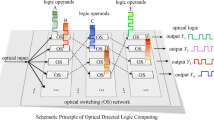Abstract
Conventional optical burst switching (OBS) is incapable of providing connection-oriented service, and burst loss is more likely to occur with increasing of traffic load due to its inherent architecture where the burst size is variable. In this paper, we propose and evaluate the optical time-slot switching technology, in which the fixed-size time-slot is adopted as the basic switching granularity, and switching is done in the time domain, rather than the wavelength domain. Also, we prove that time-slot switching has an equivalent function to eliminate data conflict relative to wavelength converter. Subsequently, the routing, wavelength, and time-slot assignment problem is studied in this paper. An adaptive weight function is introduced to the routing and wavelength selection algorithm, then several useful approaches, such as the train approach, wagon approach and p-distribution approach, are presented for time-slot assignment and scheduling. The results show that our scheme can perform better than conventional OBS in the aspect of blocking performance, quality of service, and class of service.
Similar content being viewed by others
References
Qiao C., Yoo M.: Optical burst switching (OBS): a new paradigm for an optical internet. J. High Speed Netw. 8(1), 69–84 (1999)
Turner J.S.: Terabit burst switching. J. High Speed Netw. 8(1), 3–16 (1999)
Chen Y., Qiao C., Yu X.: Optical burst switching (OBS): a new area in optical networking research. IEEE Netw. 18(3), 16–23 (2004)
Zalesky, A.: To burst or circuit switch? IEEE/ACM Trans. Netw. 17(1), (Feb. 2009)
Wei J.Y., McFarland R.I.: Just-in-time signaling for WDM optical burst switching networks. IEEE/OSA J. Lightwave Technol. 18(12), 2019–2037 (2000)
Baldine I., Rouskas G.N., Perros H.G., Stevenson D.: Jump start: a just-in-time signaling architecture for WDM burst-switched networks. IEEE Commun. Mag. 40(2), 82–89 (2002)
Chen, Y., Turner, J.S.: WDM burst switching for petabit capacityrouters. In: Proceedings of IEEE Mil. Commun. Conf. pp. 968–973, Atlantic City (1999)
Xiong Y., Vandenhoute M., Cankaya H.C.: Control architecture in optical burst-switched WDM networks. IEEE J. Sel. Areas Commun. 18(10), 1838–1851 (2000)
Xu J., Qiao C., Li J., Xu G.: Efficient burst scheduling algorithms in optical burst-switched networks using geometric techniques. IEEE J. Sel. Areas Commun. 22(9), 1796–1881 (2004)
Liu, X., Saberi, N., Coates, M., Mason, L.: A comparison between time-slot scheduling approaches for all-photonic networks. In: Proceedings of Fifth International Conference on Information, Communications and Signal, Bangkok, pp. 1197–1201 (2005)
Chen A., Wong K.S., Lea C.T.: On the space reuse efficiency of TSI-free OTDM rings. IEEE Commun. Lett. 12, 322–324 (2008)
Rugsachart, A., Thompson, R.A.: Optimal timeslot size for synchronous optical burst switching. In: Proceedings of Fourth International Broadband Communications, Networks and Systems, Raleigh, pp. 17–22. (2007)
Hayashitani M., Kasahara T., Ishii D., Arakawa Y., Okamoto S., Yamanaka N., Takezawa N., Nashimoto K.: GMPLS-based optical slot switching access-distribution network with a 10 ns high-speed PLZT optical switch. J. Opt. Netw. 7(8), 744–758 (2008)
Hernandez J.A., Aracil J., Lopez V., Garcia-Dorado J.L., Pedro L.: Performance analysis of asynchronous best-effort traffic coexisting with TDM reservations in polymorphous OBS networks. Photonic Netw. Commun. 17(2), 93–103 (2008)
Jordan H.F., Lee D., Lee K.Y., Ramanan S.V.: Serial array time slot interchangers and optical implementations. IEEE Trans. Comput. 43, 1309–1318 (1994)
Cardakli M.C., Gurkan D., Havstad S.A., Willner A.E., Parameswaran K.R., Fejer M.M., Brener I.: Tunable all-optical time-slot-interchange and wavelength conversion using difference-frequency-generation and optical buffers. IEEE Photonics Technol. Lett. 14(2), 200–202 (2002)
Zouraraki, O., Petrantonakis, D., Yiannopoulos, K., Meleiro, R., Sadeghioon, L.M., Poustie, A., Maxwell, G., Varvarigos, E., Vlachos, K., Monteiro, P., Simeonidou, D., Avramopoulos, H.: Optically-addressable packet timeslot interchanger using a quadruple switch array. In: Proceedings of Optical Fiber Communication and the National Fiber Optic Engineers Conference, Anaheim, pp.1–3. (2007)
Bhide N.M., Sivalingam K.M., Fabry-Asztalos T.: Routing mechanisms employing adaptive weight functions for shortest path routing in multi-wavelength optical WDM networks. J. Photonic Netw. Commun. 3(3), 227–236 (2001)
Author information
Authors and Affiliations
Corresponding author
Additional information
This work is jointly supported by the Natural Science Foundation of China (60496315, 60802009), National 863 project of China (2008AA01Z204, 2009AA01Z205) and International Cooperation in Science and Technology Project (2008DFA11630).
Rights and permissions
About this article
Cite this article
Shan, G., Zhu, G. & Liu, D. Study on the problem of routing, wavelength, and time-slot assignment towards optical time-slot switching technology. Photon Netw Commun 22, 162–171 (2011). https://doi.org/10.1007/s11107-011-0316-0
Received:
Accepted:
Published:
Issue Date:
DOI: https://doi.org/10.1007/s11107-011-0316-0




